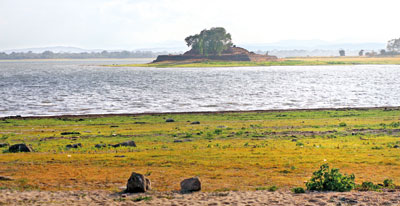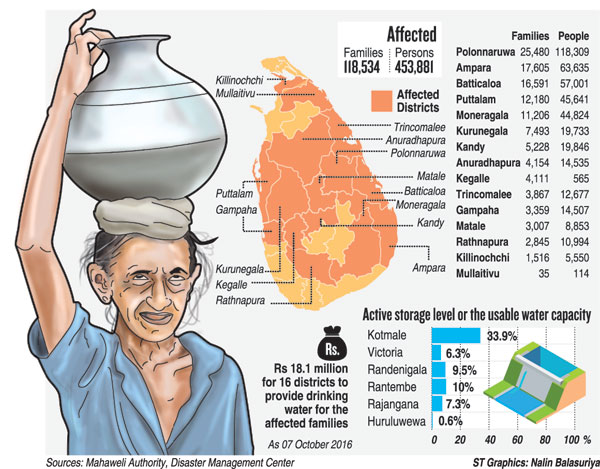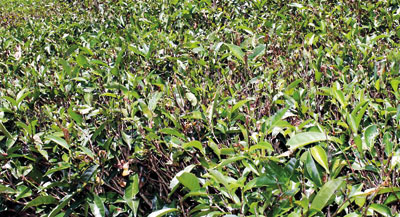News
Bitter brew for low- country tea estates as drought hits

Dried up Parakkrama Samudraya
Severe drought conditions across the country are hitting crops hard, with bushes withering in some tea plantations, forcing some companies to cut work for estate workers.
The tea does not taste as “strong, brisk and creamy as it did once,” says S. Satharasinghe, a professional tea-taster. Along with waning taste, the industry is grappling with diminishing production and reduced prices, he said.
Small tea plantations provide the main source of income for nearly 85 per cent of the population in the Balangoda area.
“We are facing all kinds of problems. The crop perspective is very bad”, the factory manager of Broadlands Tea Factory at Kalugala in the Nuwara Eliya district, Nilantha Weerasinghe, said.
He said the harvest was very low. “We are losing more than 70 per cent of crops, which is very bad for the viability of the estate because a lot of bushes are dying,” he said.
“The usual lifespan of a tea plant is about 20 years. In our areas, most tea planters decided to re-plant stocks a few years ago. It takes about two to three years for a bush to be ready for harvesting.
“For the past two months, tea-plucking has been limited to one harvest a month rather than on the normal weekly basis.”
The decrease is alarming, he said, with daily produce going down from 5000kg to 4000kg and now 2000kg inside a week.
Planters’ Association of Ceylon Secretary-General Malin Gunathileka said small-holders are mainly in the low country, from where more than 50 per cent of tea production comes – there are 160,000 small-holders in Ratnapura, 100,000 in Galle and 75,000 in Matara.
“Small tea growers don’t have the resources to deal with climate change,” he said.
Along with stunted growth, increased dampness has led to an upsurge in pests. “Minor pests have become major pests,” Mr. Gunathileka said.
The association is testing clones that are resistant to climate change.
Coconut cultivators point out that the coconut harvests in the districts of Puttalam and Trincomalee will drop sharply in coming months due to the drought. Since water springs were drying up, coconut shoots had begun to wither.
The prices of vegetables have increased in the Dambulla Economic Centre and Colombo Manning Market due to the decrease in the quantity of vegetables.
“We normally get about 500 bags of brinjals a day,” the secretary of the Manning Market’s welfare society, Gamini Handunge said. “Today, we didn’t even get 50. At present, the quantity of substandard vegetables is higher, because most of what we receive is ‘vehi elavalu’ [sodden].”

Dried and withered tea bushes
The Census and Statistics Department states that compared to last year, the price of leeks has increased by 44.4 per cent, long beans by 42 per cent, carrots by 41.2 per cent, beetroot by 25.9 per cent, brinjal by 34 per cent and snakegourd by 25 per cent.
All-Ceylon Agrarian Association Chief Organiser Namal Karunaratne blames the government for what he called inefficient management of water resources, which comprise 14,000 rivers, streams and reservoirs islandwide.
The onset of the inter-monsoonal rains will be by October 15 but the Meteorological Department said there were doubts whether the country would receive sufficient monsoon rains.
Meteorology Department Duty Forecaster Janaka Bandara said that, heavy rains over catchments could not be counted on; there would be irregular, intermittent showers during the day and night.
There will be strong winds in the Western and Sabaragamuwa provinces as the south-west monsoon is currently active and showers could be anticipated in the Matara area.
| Govt. ‘fights’ sale of potable water in drought-affected areas: Minister Disaster Management Minister Anura Priyadarshana Yapa told Parliament this week that steps have been taken to prevent unscrupulous persons making money by selling water at a time when many districts are experiencing a severe water shortage due to the drought, particularly, a shortage in drinking water. “We cannot stop the sale of water to a few individuals but, we will not allow it to become a business. The Ministry has released sufficient funds to the District Secretariats to distribute water to the affected areas,” the Minister said. The Minister made this comment in response to a query raised by UPFA Colombo District MP Dinesh Gunawardena who cited the Sunday Times report of October 2, titled “Thirsty for water and justice”, which said the sale of water has become a lucrative business in some areas such as Tissamaharama, where people were paying Rs 2,000 for a 5,000-litre bowser of water and Rs 1,000 for a 2,000-litre bowser. The Minister said they had received reports of water being sold and have informed the District Secretaries to ensure this is not allowed. MP Dinesh Gunawardena said that, along with the water shortage, there were also reports on rising temperatures and steps must be taken to ensure a long term action plan is implemented to deal with this situation. Minister Yapa said that nearly 453,881 persons from 118,534 families were affected by the prevailing drought, and the Government was taking all measures to provide assistance to them. |
| Drinking water trucked to thousands of families The drought is causing hardship to some 453,880 people in several districts. More than 46,624 families in the Polonnaruwa, Trincomalee, Batticaloa, Killinochchi, Vavuniya, Kurunegala and Ratnapura districts are short of drinking water and the Disaster Management Ministry (DMM) has taken measures to provide drinking water free of charge for the affected families via the District Secretariats. The DMM has already released Rs 18.1 million for 16 districts to provide drinking water and measures have also been taken to distribute 1000-litre water tanks to the Polonnaruwa, Batticaloa, Ampara, Kurunegala, Puttalam, Matale, Kalutara districts. The army is supplying drinking water to drought-hit areas of Welikanda, Dimbulagala, Lankapura, Thamankaduwa, Medirigiriya and Hingurakgoda areas in the east. In Polonnaruwa, one of the worst-affected areas, the drought has hit more than 118,000 persons, the Disaster Management Centre (DMC) said. The second hardest hit district is Batticaloa. The Mahaweli Authority said the levels in reservoirs in the North Central and Central provinces had dropped drastically, with the usable water capacity of the Kotmale reservoir being 33.9 per cent, Victoria 6.3 per cent, Randenigala 9.5 per cent, Rantembe 10 per cent, Rajangana 7.3 per cent and Huruluwewa 0.6 per cent. “We have not come to a critical stage yet,” Mahaweli Authority Senior Engineer and Director S.R.K, Aruppola said. “If we receive adequate rainfall within the next few weeks we might recover but if we don’t, we will limit water storage to the critical level. “At present, we are releasing water for power generation only for two hours per day.” |

